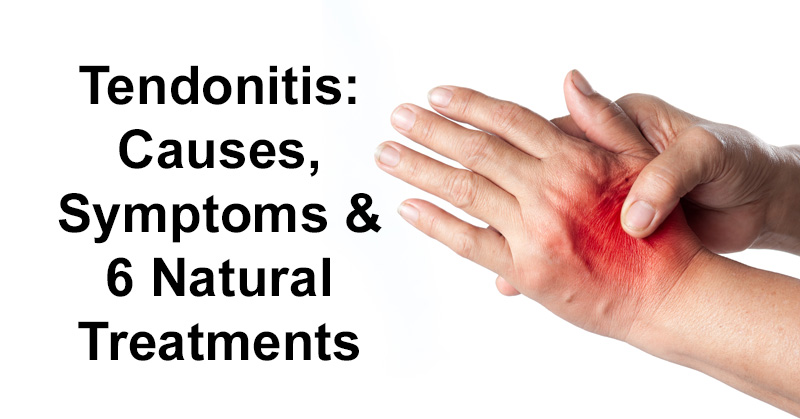Tendonitis is an inflammation or irritation of a tendon, which is a thick cord that attaches bone to muscle. Signs and tendonitis symptoms include pain, swelling, and stiffness near the joint in question. Additionally, tendonitis causes, at times, restricted movement of the affected joint. (1) However, there are a number of tendonitis treatment methods you can try to help lesson symptoms.

Tendonitis causes vary and include such activities as: (2)
- Gardening
- Raking
- Carpentry
- Cleaning house
- Shoveling
- Painting
- Scrubbing
- Tennis
- Golf
- Skiing
- Throwing and pitching
- Occasionally an infection can cause tendinitis, especially infection from a cat or dog bite to the hand or a finger.
Tendonitis symptoms include:
- Pain or tenderness at or near a joint, often around a shoulder, wrist, elbow, or ankle
- Stiffness that, in conjunction with the pain, restricts the movement of the joint in question
- Mild swelling or thickening of the tendon near the joint in question
Here are 6 natural tendonitis treatment methods:
1. Refrain from Exercise; Rest
While it might be hard for you to take a break from sports and exercise, doing so can help you recover at a much faster rate. If you can, pinpoint what activity in particular was the culprit. Avoid said activity until symptoms decrease. When you start the activity again, be sure to keep it at low-intensity and take plenty of breaks. If you choose to remain active, avoid activities that make your symptoms worse.
2. Start New Exercises Slowly and Take Breaks
A common trigger for tendonitis is starting an exercise routine too quickly or not taking enough rests. Overtaxing your body can increase inflammation, which promotes development of tendonitis.
Start new exercise programs slowly, even if you’re a well-seasoned athlete. Your body isn’t used to the new motions. Furthermore, make sure you take rest days so your body can have time to repair itself. (3)
3. Adopt An Anti-Inflammatory Diet

Inflammation can worsen tendonitis symptoms. To keep inflammation in check, adopt an anti-inflammatory diet.
For a tendonitis treatment, be sure to include these foods in your diet:
- All types of vegetables, especially leafy greens: Vegetables have antioxidants that fight oxidative stress, which is one of the main causes of inflammation. Try kale, broccoli, spinach and other greens. Leafy and cruciferous vegetables.
- Berries: Berries are chock-full of vitamin C, which helps with rebuilding collagen. You can also eat citrus fruits, squash, green veggies and bell peppers to get your vitamin C. Pineapple is a good choice as well as it supplies bromelain, which can help treat swelling an injuries.
- High-potassium and magnesium foods: Potassium can speed up healing. Try coconut water, avocados, greens and bananas. And magnesium, found in these same foods, are great for muscle recovery and healthy circulation.Tendonitis treatment also involves avoiding triggering foods. For example, these foods can make symptoms worse:
- Alcohol and caffeine: Alcohol and caffeine often prolongs inflammation, as well as it does bone loss.
- Too much sodium and salt: Sodium, which is found in almost all packaged foods, counteracts potassium. Furthermore, too much sodium leads to a loss of important nutrients in your body needed for the healing process. Avoid high-sodium foods as much as possible.
- Sugar and refined grains: These can also promote inflammation. Furthermore, high levels of added sugar can lower immune function as well as slow down healing time.
Hydrogenated oils and fried foods: Refined oils also cause inflammation.
4. Try Ice Packs
Use an ice pack to help sooth pain and decrease inflammation. This is particular necessary during the first couple of days of injury, when swelling is likely at its worst. Don’t put the pack directly on your skin, however; use a barrier like a cloth or paper towel. Ice for 20 minute increments several times a day.
5. Consider Wearing a Splint or Brace

You can add extra support around your tendons by wearing a bandage, splint, or brace. Doing so can help keep that part of your body from moving around too much. Furthermore, isolating the tendon that is inflamed can help reduce swelling as well as promote healing.
6. Talk to a Doctor about Alternative Treatments
If needed, you might talk to your doctor about other ways to treat tendonitis. For example:
- Prescription or over-the-counter painkillers: Typically, for mild pain, the occasional ibuprofen can help. However, for more severe pain, prescription gels may be prescribed to be applied topically.
- Physical therapy: A physical therapist can help you learn isolated motions to help with tendon injuries.
- Chiropractic treatments: A chiropractor can give you tips for performing tasks in a safe manner. Furthermore, they can show you helpful techniques related to stretching, flexibility, and proper posture to decrease injury risk.
- Corticosteroid injections: Steroid injections can be a quick-fix, but due to adverse side effects, it’s not meant for long-term use. (4)
- Extracorporeal shock wave therapy (ESWT): Your doctor may have you try ESWT as a last resort. ESWT is a low-pain option that sends shock waves through your skin to the tendon to break up deposits that have built up. It does, however, come with its own set of side effects, so proceed with caution. (5)
- Surgery is another treatment option, however, it comes with complications. For example, adverse reactions to anesthesia and medications, infections, scarring, and rupturing the tendon can all be possible side effects.
Giving your body the rest it needs is paramount in order to recover from an injury like tendonitis. Take it slow, and consider changing your diet to promote a environment more conducive to healing.


